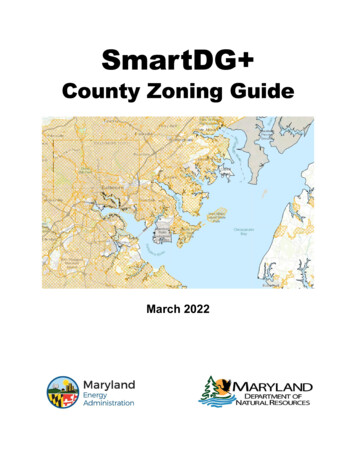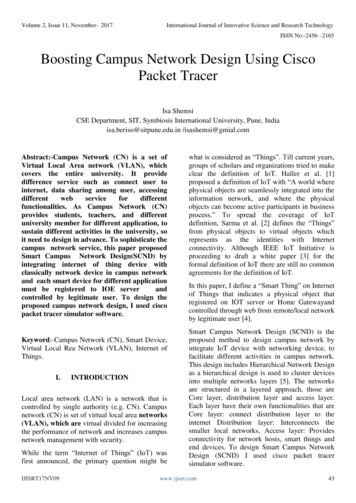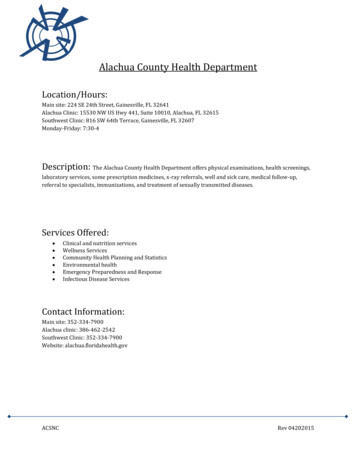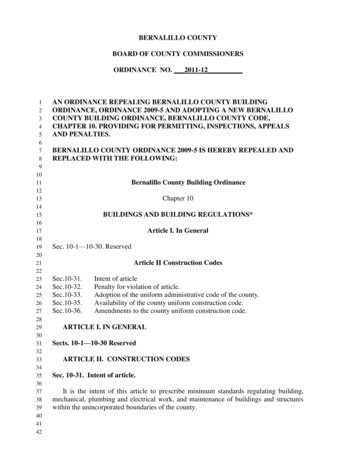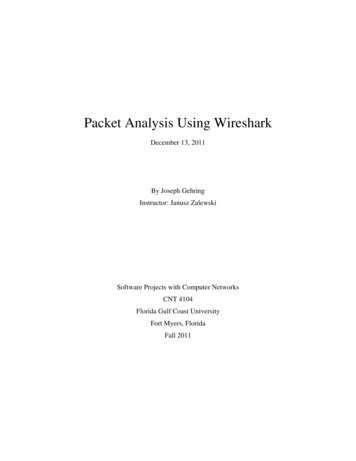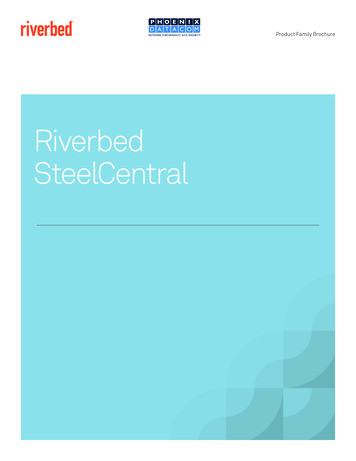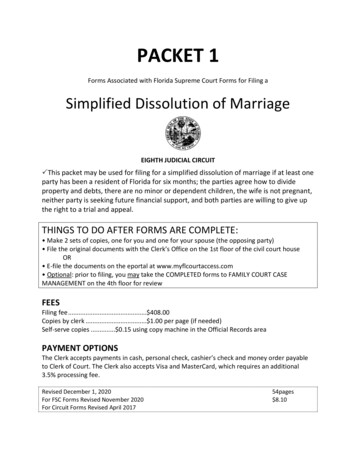
Transcription
PACKET 1Forms Associated with Florida Supreme Court Forms for Filing aSimplified Dissolution of MarriageEIGHTH JUDICIAL CIRCUIT This packet may be used for filing for a simplified dissolution of marriage if at least oneparty has been a resident of Florida for six months; the parties agree how to divideproperty and debts, there are no minor or dependent children, the wife is not pregnant,neither party is seeking future financial support, and both parties are willing to give upthe right to a trial and appeal.THINGS TO DO AFTER FORMS ARE COMPLETE: Make 2 sets of copies, one for you and one for your spouse (the opposing party) File the original documents with the Clerk’s Office on the 1st floor of the civil court houseOR E-file the documents on the eportal at www.myflcourtaccess.com Optional: prior to filing, you may take the COMPLETED forms to FAMILY COURT CASEMANAGEMENT on the 4th floor for reviewFEESFiling fee . 408.00Copies by clerk . 1.00 per page (if needed)Self-serve copies . 0.15 using copy machine in the Official Records areaPAYMENT OPTIONSThe Clerk accepts payments in cash, personal check, cashier’s check and money order payableto Clerk of Court. The Clerk also accepts Visa and MasterCard, which requires an additional3.5% processing fee.Revised December 1, 2020For FSC Forms Revised November 2020For Circuit Forms Revised April 201754pages 8.10
Pkt 1PgSIMPLIFIED DISSOLUTIONOF MARRIAGEYou may use these forms if all of the following are true:1. At least one party has been a resident of Florida for six months;2. The parties agree that the marriage cannot be saved;3. The parties have no minor or dependent children and the wife is not pregnant;4. The parties have agreed on how to divide property and debts;5. Neither party is seeking future financial support;6. Both parties are willing to give up the right to a trial and appeal.2
Pkt 1Pg3CONTENTS1. Proving Residency . 42. Warning to Self-Represented (Pro Se) Litigants . 53. Resources for Litigants filing a Family Law Action without Legal Counsel . 64. Family Court Self Help Center Information . 75. Permission to Use E-Mail . 96. Cover Sheet for Family Court Cases, Form 12.928 . 107. General Information for Self-Represented Litigants . 128. Family Law Glossary Of Common Terms And Definitions . 179. Disclosure from Non-lawyer, Form 12.900(a) . 2310. Affidavit of Corroborating Witness and Instructions, Form 12.902(i) . 2411. Petition for Simplified Dissolution, Form 12.901(a) . 2712. Standing Family Court Orders (one for each petitioner) . 3213. Notice of Social Security Number – Petitioner, Form 12.902(j) . 3414. Notice of Social Security Number – Respondent, Form 12.902(j) . 3815. Notice of Related Cases, Form 12.900(h) . 4216. Marital Settlement Agreement for Simplified Dissolution, Form 12.902(f)(3) . 47
Pkt 1PgPROVING RESIDENCYYou or your spouse may prove that you have been a resident ofFlorida for at least six months by doing one of the following:1.Filing with the Clerk of Court a copy of a valid Florida driver’s license orvoter registration card issued at least six months ago;2.Bringing a witness to your court hearing who can testify that you meetthe requirement; or3.Completing and filing with the Clerk of Court an Affidavit ofCorroborating Witness on the form provided in this packet.4
Pkt 1Pg5WARNINGIF THERE IS ANY QUESTION in your mind concerning these forms, the use of theseforms, or your legal rights, it is strongly recommended that you obtain theservices of an attorney. If you do not know an attorney, you may contact theFlorida Lawyer Referral Service at 1-800-342-8011. If you are filing for divorce in acase involving domestic violence and are financially unable to afford the servicesof an attorney, you may contact Three Rivers Legal Services at (352) 372-0519 or1-800-372-0936 to see if you are eligible for their services.DUE TO THE CHANGING NATURE OF THE LAW, the forms and informationcontained in this packet may become outdated. Therefore, you should review andresearch statutes and rules of procedure referenced in the instructions to ensurethat the forms are accurate and current.IN NO EVENT will the Florida Supreme Court, the Florida Bar, the Eighth JudicialCircuit Office of the Court Administrator, the Clerk of the Court or anyonecontributing to the production of these forms, commentary, instructions, andappendices be liable for any indirect or consequential damages resulting from theuse of the packet.Use these forms at your own risk. These forms may or may not be appropriate inyour particular case. Any desired outcome from the use of these forms cannot bepredicted or guaranteed. It is strongly recommended that you seek legal advice.When the forms refer to: “General Information for Self-Represented Litigants),”the information is found at http://www.flcourts.org (select Family Forms locatedunder the heading Self Help in the General Public Tab).
EIGHTH JUDICIAL CIRCUITResources for Litigants Filing a Family Law ActionWithout Legal CounselInformation on how to file family law cases without an attorney in the State of Floridacan be found at:http://circuit8.org/family-court or http://www.flcourts.org (select FamilyForms located under the heading Self Help in the General Public Tab)Internet access and procedural guidance is available at the Self Help Center, Room413, of the Family/Civil Justice Center.Other helpful sites:Family Advocacy advocacy-clinicFlorida Bar Referral Service(800) 342-8011http://www.floridabar.org/lawyerreferral3 Rivers Legal Services, Inc. - Gainesville Office(352) 372-0519http://www.trls.org
Pkt 1Pg7FAMILY COURTSELF HELP CENTEREIGHTH JUDICIAL CIRCUITSERVING ALACHUA COUNTYA PROGRAM OF THE ADMINISTRATIVE OFFICE OF THE COURTThe Self Help Center staff is employed by the Court to assist the Family Law Judges by makingsure that all cases in which the petitioner is not represented by an attorney have metprocedural requirements.As in all matters involving law, it is recommended that you obtain the services of a competentlawyer. It is important for you to understand that the Court and Program staff do not representyou. YOU represent yourself.If you decide to proceed without a lawyer, the Self Help Center staff will: explain procedures guide you on informative and helpful websites inform you about additional court requirements help you set a hearing with the judgeThe staff will not: give legal advice or explain rights represent you in court tell you what forms to file tell you how to present your case notify you that your case is ready to file
Pkt 1Pg8PROCEDURESIf you have decided to file a family law case without a lawyer, please follow these steps:1. Purchase the applicable form and/or packet from the Clerk of the Court or download theforms from the Clerk’s website at www.alachuaclerk.org.2. Complete the packet of forms - in ink or typed. Court staff cannot assist you in completingthe forms.3. Instructions regarding filing and procedures are addressed in the packet. Proceduralquestions can be answered by calling (352)548-3781 or visiting the Self Help Center,Alachua County Family/Civil Justice Center, 201 E. University Avenue, Room 413,Gainesville, Florida 32601.4. Further instructions regarding procedures after filing are addressed in the packet. Your casewill be monitored for procedural requirements by the Self Help Center staff.Helpful websites -- information on how to file family law cases without an attorney in the Stateof Florida can be found at:Eighth Judicial Circuit Florida Supreme Court Website:http://www.flcourts.org (select Family Forms located under the heading Self Help in theGeneral Public Tab)
Pkt 1Pg9IN THE CIRCUIT COURT OF THE EIGHTH JUDICIAL CIRCUITIN AND FOR ALACHUA COUNTY, FLORIDACASE NO:DIVISION:,Plaintiff/ Petitioner/Statev.,Defendant/ RespondentPERMISSION TO USE E-MAILProvide your email address below to receive a copy of your Orders, Judgments Notice of Hearingsor other written communications from the court or clerk of court and by electronic mail.*By completing this form I am authorizing the Court and the Clerk, of Circuit Court to send copies oforders/judgments, notices or other written communications to me by e-mail.I will ensure the software filters have been removed from my computer, so it does not interferewith my ability to receive any of the above documents.I will file a written notice with the Clerk, if my current email address changes.Plaintiff/ Petitioner Name (print)Plaintiff/ Petitioner Name (signature)* email address (print clearly)Date
Pkt 1I.Pg10Cover Sheet for Family Court Cases (11/13)Case StyleIN THE CIRCUIT COURT OF THE EIGHTH JUDICIAL CIRCUIT,IN AND FOR ALACHUA COUNTY, FLORIDAandPetitionerCase No.:RespondentII. Type of Action/Proceeding. Place a check beside the proceeding you are initiating. If you aresimultaneously filing more than one type of proceeding against the same opposing party, such as amodification and an enforcement proceeding, complete a separate cover sheet for each action beingfiled. If you are reopening a case, choose one of the three options below it.(A) X Initial Action/Petition(B) Reopening Case1. Modification/Supplemental Petition2. Motion for Civil Contempt/Enforcement3. OtherIII. Type of Case. If the case fits more than one type of case, select the most definitive.(K) UIFSA Non‐IV‐D (not Department of(A) X Simplified Dissolution of MarriageRevenue, Child Support Enforcement)(B) Dissolution of Marriage(L) Other Family Court(C) Domestic Violence(M) Adoption Arising Out of Chapter 63(D) Dating Violence(N) Name Change(E) Repeat Violence(O) Paternity/Disestablishmentof(F) Sexual ViolencePaternity(G) Stalking(P) Juvenile Delinquency(H) Support IV‐D (Dept. of Revenue, Child(Q) Petition for DependencySupport Enforcement)(R) Shelter Petition(I) Support Non‐IV‐D (not Dept. of(S)Termination of Parental Rights ArisingRevenue, Child Support Enforcement)Out of Chapter 39(J) UIFSA IV‐D (Department of Revenue,(T)Adoption Arising Out of Chapter 39Child Support Enforcement)(U) CINS/FINSIV. Rule of Judicial Administration 2.545(d) requires that a Notice of Related Cases Form, Family Law Form12.900(h), be filed with the initial pleading/petition by the filing attorney or self-represented litigantin order to notify the court of related cases. Is Form 12.900(h) being filed with this Cover Sheet forFamily Court Cases and initial pleading/petition?No, to the best of my knowledge, no related cases exist.Yes, all related cases are listed on Family Law Form 12.900(h).Florida Family Law Rules of Procedure Form 12.928, Cover Sheet for Family Court Cases (11/13)
Pkt 1Pg11ATTORNEY OR PARTY SIGNATUREI CERTIFY that the information I have provided in this cover sheet is accurate to the best of myknowledge and belief.SignatureFL Bar No.:Attorney or party(Type or print name)(Bar number, if attorney)DateIF A NONLAWYER HELPED YOU FILL OUT THIS FORM, HE/SHE MUST FILL IN THE BLANKS BELOW:[fill in all blanks]This form was prepared for the: {choose only one} ( ) Petitioner ( ) RespondentThis form was completed with the assistance of:{name of individual}{name of business}{address}{city}, {state} , {telephone number}Florida Family Law Rules of Procedure Form 12.928, Cover Sheet for Family Court Cases (11/13)
Pkt 1Pg12FAMILY LAW FORMS, COMMENTARY, AND INSTRUCTIONSGENERAL INFORMATION FOR SELF-REPRESENTED LITIGANTS(02/18)You should read this General Information thoroughly before taking any other steps to file your case orrepresent yourself in court. Most of this information is not repeated in the attached forms. Thisinformation should provide you with an overview of the court system, its participants, and its processes.It should be useful whether you want to represent yourself in a pending matter or have a betterunderstanding of the way family court works. This is not intended as a substitute for legal advice froman attorney. Each case has its own particular set of circumstances, and an attorney may advise you ofwhat is best for you in your individual situation.These instructions are not the only place that you can get information about how a family case works.You may want to look at other books for more help. The Florida Statutes, Florida Family Law Rules ofProcedure, Florida Rules of Civil Procedure, and other legal information or books may be found at thepublic library or in a law library at your county courthouse or a law school in your area. If you are filing apetition for Name Change and/or Adoption, these instructions may not apply.If the word(s) is printed in bold, this means that the word is being emphasized. Throughout theseinstructions, you will also find words printed in bold and underlined. This means that the definitions ofthese words may be found in the glossary of common family law terms at the end of this generalinformation section.Commentary1995 Adoption. To help the many people in family law court cases who do not have attorneys torepresent them (pro se litigants), the Florida Supreme Court added these simplified forms and directionsto the Florida Family Law Rules of Procedure. The directions refer to the Florida Family Law Rules ofProcedure or the Florida Rules of Civil Procedure. Many of the forms were adapted from the formsaccompanying the Florida Rules of Civil Procedure. Practitioners should refer to the committee notes forthose forms for rule history.The forms were adopted by the Court pursuant to Family Law Rules of Procedure, 667 So. 2d202 (Fla. 1995); In re Petition for Approval of Forms Pursuant to Rule 10-1.1(b) of the Rules Regulatingthe Florida Bar—Stepparent Adoption Forms, 613 So. 2d 900 (Fla. 1992); Rules Regulating the FloridaBar—Approval of Forms, 581 So. 2d 902 (Fla. 1991).Although the forms are part of these rules, they are not all inclusive and additional forms, asnecessary, should be taken from the Florida Rules of Civil Procedure as provided in Florida Family LawRules of Procedure. Also, the following notice has been included to strongly encourage individuals toseek the advice, when needed, of an attorney who is a member in good standing of the Florida Bar.1997 Amendment. In 1997, the Florida Family Law Forms were completely revised to simplifyand correct the forms. Additionally, the appendices were eliminated, the instructions contained in theappendices were incorporated into the forms, and the introduction following the Notice to Parties wascreated. Minor changes were also made to the Notice to Parties set forth below.NOTICE TO PARTIES WHO ARE NOT REPRESENTED BY AN ATTORNEY WHO IS A MEMBER INGOOD STANDING OF THE FLORIDA BARIf you have questions or concerns about these forms, instructions, commentary, the use of the forms,or your legal rights, it is strongly recommended that you talk to an attorney. If you do not know anattorney, you should call the lawyer referral service listed in the yellow pages of the telephone bookGeneral Information for Self-Represented Litigants (02/18)
Pkt 1Pg13under “Attorney.” If you do not have the money to hire an attorney, you should call the legal aidoffice in your area.Because the law does change, the forms and information about them may have become outdated.You should be aware that changes may have taken place in the law or court rules that would affectthe accuracy of the forms or instructions.In no event will the Florida Supreme Court, The Florida Bar, or anyone contributing to the productionof these forms or instructions be liable for any direct, indirect, or consequential damages resultingfrom their use.FAMILY LAW PROCEDURESCommunication with the court Ex parte communication is communication with the judge with only oneparty present. Judges are not allowed to engage in ex parte communication except in very limitedcircumstances, so, absent specific authorization to the contrary, you should not try to speak with orwrite to the judge in your case unless the other party is present or has been properly notified. If youhave something you need to tell the judge, you must ask for a hearing and give notice to the otherparty or file a written statement in the court file and send a copy of the written statement to theother party.Filing a case. A case begins with the filing of a petition. A petition is a written request to the court forsome type of legal action. The person who originally asks for legal action is called the petitioner andremains the petitioner throughout the case.A petition is given to the clerk of the circuit court, whose office is usually located in the countycourthouse or a branch of the county courthouse. A case number is assigned and an official court file isopened. Delivering the petition to the clerk’s office is called filing a case. A filing fee is usually required.Once a case has been filed, a copy must be given to (served on) the respondent. The person againstwhom the original legal action is being requested is called the respondent, because he or she isexpected to respond to the petition. The respondent remains the respondent throughout the case.Service. When one party files a petition, motion, or other pleading, the other party must be “served”with a copy of the document. This means that the other party is given proper notice of the pendingaction(s) and any scheduled hearings. Personal service of the petition, standing order, and summons onthe respondent by a deputy sheriff or private process server is required in all original petitions fordissolution of marriage. Supplemental petitions, unless constructive service is permitted by law, mustalso be served via personal service. Personal service may also be required in other actions by somejudges. After initial service of the original or supplemental petition and summons by a deputy sheriff orprivate process server, service of most motions and other documents or papers filed in the casegenerally may be made by regular U.S. mail or hand delivery. However, service by certified mail isrequired at other times so you have proof that the other party actually received the papers. Theinstructions with each form will advise you of the type of service required for that form. If the otherparty is represented by an attorney, you should serve the attorney and send a copy to the other party,except for original or supplemental petitions, which must be personally served on the respondent.Other than the initial original or supplemental petitions, anytime you file additional pleadings ormotions in your case, you must provide a copy to the other party and include a certificate of service.Likewise, the other party must provide you with copies of everything that he or she files. Service ofGeneral Information for Self-Represented Litigants (02/18)
Pkt 1Pg14additional documents is usually completed by U.S. mail. For more information, see the instructions forCertificate of Service (General), Florida Supreme Court Approved Family Law Form 12.914.Forms for service of process are included in the Florida Family Law Forms, along with more detailedinstructions and information regarding service. The instructions to those forms should be read carefullyto ensure that you have the other party properly served. If proper service is not obtained, the courtcannot hear your case.Note: If you absolutely do not know where the other party to your case lives or if the other party residesin another state, you may be able to use constructive service. However, if constructive service is used,other than granting a divorce, the court may only grant limited relief. For more information onconstructive service, see Notice of Action for Dissolution of Marriage, Florida Supreme Court ApprovedFamily Law Form 12.913(a), and Affidavit of Diligent Search and Inquiry, Florida Family Law Rules ofProcedure Form 12.913(b). Additionally, if the other party is in the military service of the United States,additional steps for service may be required. See, for example, Memorandum for Certificate of MilitaryService, Florida Supreme Court Approved Family Law Form 12.912(a). In sum, the law regardingconstructive service and service on an individual in the military service is very complex and you maywish to consult an attorney regarding these issues.Default. After being served with a petition or counterpetition, the other party has 20 days to file aresponse. If a response to a petition is not filed, the petitioner may file a Motion for Default, FloridaSupreme Court Approved Family Law Form 12.922(a), with the clerk. This means that you may proceedwith your case and set a final hearing, and a judge will make a decision, even if the other party will notcooperate. For more information, see rule 12.080(c), Florida Family Law Rules of Procedure.Answer and Counterpetition. After being served, the respondent has 20 days to file an answeradmitting or denying each of the allegations contained in the petition. In addition to an answer, therespondent may also file a counterpetition. In a counterpetition, the respondent may request the sameor some other relief or action not requested by the petitioner. If the respondent files a counterpetition,the petitioner should then file an Answer to Counterpetition, Florida Supreme Court Approved FamilyLaw Form 12.903(d), and either admit or deny the allegations in the respondent’s counterpetition.Mandatory disclosure. Rule 12.285, Florida Family Law Rules of Procedure, requires each party in adissolution of marriage to exchange certain information and documents, and file a Family Law FinancialAffidavit, Florida Family Law Rules of Procedure Form 12.902(b) or (c). Failure to make this requireddisclosure within the time required by the Florida Family Law Rules of Procedure may allow the court todismiss the case or to refuse to consider the pleadings of the party failing to comply. This requirementalso must be met in other family law cases, except adoptions, simplified dissolutions of marriage,enforcement proceedings, contempt proceedings, and proceedings for injunctions for domestic orrepeat violence. The Certificate of Compliance with Mandatory Disclosure, Florida Family Law Rules ofProcedure Form 12.932, lists the documents that must be given to the other party. For moreinformation see rule 12.285, Florida Family Law Rules of Procedure, and the instructions to theCertificate of Compliance with Mandatory Disclosure, Florida Family Law Rules of Procedure Form12.932.Parenting Plan. If your case involves minor or dependent child(ren), a Parenting Plan shall be approvedor established by the court. Parenting Plan, Florida Supreme Court Approved Family Law Form,12.995(a) or Safety-Focused Parenting Plan, Florida Supreme Court Approved Family Law Form12.995(b). The Parenting Plan shall be developed and agreed to by the parents and approved by a court .If the parents cannot agree, or if the agreed Parenting Plan is not approved, the court must establish aParenting Plan. The Parenting Plan shall contain a time-sharing schedule and should address the issuesregarding the child(ren)’s education, health care, and physical, social, and emotional well-being.Setting a hearing or trial. Generally, the court will have hearings on motions, final hearings onuncontested or default cases, and trials on contested cases. Before setting your case for final hearing ortrial, certain requirements such as completing mandatory disclosure and filing certain papers and havingGeneral Information for Self-Represented Litigants (02/18)
Pkt 1Pg15them served on the other party must be met. These requirements vary depending on the type of caseand the procedures in your particular jurisdiction. For further information, you should refer to theinstructions for the type of form you are filing.Next, you must obtain a hearing or trial date so that the court may consider your request. You shouldask the clerk of court, or family law intake staff about the local procedure for setting a hearing or trial,which you should attend. These family law forms contain orders and final judgments, which the judgemay use. You should ask the clerk of court or family law intake staff if you need to bring one of theseforms with you to the hearing or trial. If so, you should type or print the heading, including the circuit,county, case number, division, and the parties’ names, and leave the rest blank for the judge tocomplete at your hearing or trial.Below are explanations of symbols or parts of different family law forms.{specify}, {date}, {name(s)}, {street}, {city}, {state}, {phone}Throughout these forms, you will find hints such as those above. These tell you what to put in theblank(s).[Check one only] [all that apply]These show how many choices you should check. Sometimes you may check only one, while other timesyou may check several choices. ( ) This also shows an area where you must make a choice. Check the ( )in front of the choice that applies to you or your case.IN THE CIRCUIT COURT OF THE (1) JUDICIAL CIRCUIT,IN AND FOR (2) COUNTY, FLORIDA(5) ,Petitioner,andCase No.: (3)Division: (4)(6) ,Respondent.Line 1 The clerk of court can tell you the number of your judicial circuit. Type or print it here.Line 2 Type or print your county name on line (2).Line 3 If you are filing an initial petition or pleading, the Clerk of the Court will assign a case numberafter the case is filed. You should type or print this case number on all papers you file in thiscase.Line 4 The clerk of the court can tell you the name of the division in which your case is being filed, andyou should type or print it here. Divisions vary from court to court. For example, your case maybe filed in the civil division, the family division, or the juvenile division.Line 5 Type or print the legal name of the person who originally filed the case on line 5. This person isthe petitioner because he/she is the one who filed the original petition.Line 6 Type or print the other party’s legal name on line 6. The other party is the respondent becausehe/she is responding to the petition.I understand that I am swearing or affirming under oath to the truthfulness of the claimsmade in this petition and that the punishment for knowingly making a false statement includes finesand/or imprisonment.General Information for Self-Represented Litigants (02/18)
Pkt 1PgDated:(1)(2)16(2)(4)Signature of PetitionerPrinted Name:(3)Address:City, State, Zip:Telephone Number:Fax Number:(5)(6)(7)Some forms require that your signature be witnessed. You must sign the form in the presence of anotary public or deputy clerk (employee of the clerk of the court’s office). When signing the form, youmust have a valid photo identification unless the notary knows you personally. You should completelyfill in all lines (1 & 3–7) except 2 with the requested information, if applicable. Line 2, the signature line,must be signed in the presence of the notary public or deputy clerk.STATE OF FLORIDACOUNTY OFSworn to or affirmed and signed before me on by.NOTARY PUBLIC or DEPUTY CLERK[Print, type, or stamp commissioned name of notary orclerk.]Personally knownProduced identification. Type of identification producedDO NOT SIGN OR FILL IN THIS PART OF ANY FORM. This section of the form is to be completed by thenotary public who is witnessing your signature.IF A NONLAWYER HELPED YOU FILL OUT THIS FORM, HE/SHE MUST FILL IN THE BLANKS BELOW: [fill inall blanks]I, {full legal name and trade name of nonlawyer}(1),a nonlawyer, located at {street}(2), {city}(3),{state}(4), {phone}(5), helped {name} (6),who is the petitioner, fill out this form.This section should be completed by anyone who helps you fill out these forms but is not an attorneywho is a member in good standing of The Florida Bar, which means that he or she is not licensed topractice law in Florida.Line 1Lines 2–5Line 6The nonlawyer who helps you should type or print his or her name on line 1.The nonlawyer’s address and telephone number should be typed or printed on lines 2–5.Your name should be typed or printed on line 6.In addition, a Disclosure from Nonlawyer, Florida Family Law Rules of Procedure Form 12.900 (a),should be completed if a nonlawyer assists you. The disclosure is available as a family law form andGeneral Information for Self-Represented Litigants (02/18)
Pkt 1Pgshould be completed before the nonlawyer helps you. This is to be sure that you understand the roleand limitations of a nonlawyer. You and the nonlawyer should keep a copy of this disclosure for yourrecords.General Information for Self-Represented Litigants (02/18)17
Pkt 1Pg18FAMILY LAW GLOSSARY OF COMMON TERMS AND DEFINITIONSNote: The following definitions are intended to be helpful, BUT they are not intended to constitutelegal advice or address every p
Marital Settlement Agreement for Simplified Dissolution, Form 12.902(f)(3) . 47 . Pkt 1 Pg 4 . PROVING RESIDENCY . You or your spouse may prove that you have been a resident of Florida for at least six months by doing one of the following: 1. Filing with the Clerk of Court a copy of a valid Florida driver's license or
